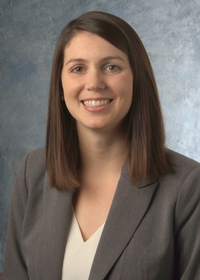CWRU faculty involved in nuclear forensic research

Christine Duval, assistant professor of Chemical and Biomoleclar Engineering
April 19, 2019
So you’ve found some uranium—now what?
This question was posed by Christine Duval, an assistant professor in the department of chemical and biomolecular engineering. Her presentation on nuclear forensic research was the final in a series hosted by the Case Western Reserve University Science and Human Rights Coalition.
Nuclear science is a rapidly advancing field. Only 44 years separate the production of the first X-ray image from the ability to weaponize nuclear technology.
Duval’s talk touched on these historical advancements, as well as the history of the atomic bomb and weapon detonation during World War II and the Cold War, before moving onto nuclear technology today.
There has been much talk in recent years about the possibility of countries developing nuclear technologies. This threat spawned the rapidly advancing field of nuclear forensics, which Duval has been a part of for several years.
Diana Zavela, a second-year student, helped coordinate Duval’s talk.
“I really liked hearing about what happens when nuclear material is found. We often hear in the news about nuclear material being detected or confiscated, and it was super interesting to hear what happens behind the scene[s]. I had no idea how we detected nuclear tests or found illegally smuggled material.”
Professionals in the nuclear forensics field work to intercept and analyze unused nuclear dust or debris left over from nuclear events.
“Our goal is to determine the composition of the material, its origin, and potentially the trafficking routes being used,” Duval explained.
One of the ways illegal nuclear testing is discovered is through environmental monitoring. Nuclear tests produce environmental stressors, such as artificial seismic waves and atmospheric sound waves. Radioactive mapping and radionuclide climate research are also used to measure increased radioactivity, indicating the presence of illegal testing.
According to Duval, “The interesting part occurs when you actually find the uranium.”
First, the material undergoes a nondestructive assay, a test to determine the content or quality of a metal ore, to ascertain whether it actually is a nuclear byproduct and not another substance. After that, it undergoes a destructive assay to determine its composition and origin, before the results are compiled and studied.
Despite the existence of several treaties on nuclear technology, the U.S. and the majority of the other signatory countries have not officially ratified any legislation. The signing is treated as an act of goodwill rather than a binding legality.
Even positive uses for nuclear technology, such as nuclear power, come with issues.
The U.S. is currently not repossessing the nuclear waste that comes from its power plants—waste which includes weapons grade uranium—in an effort to be a role model for other countries. However, the issue of what to do with the waste and where to put it remains a problem that no one currently has an appropriate answer for.
Duval encouraged all attendees to get involved in the field in a variety of different ways. She explained, “everyone has a stake in nuclear power and its legacy.”

